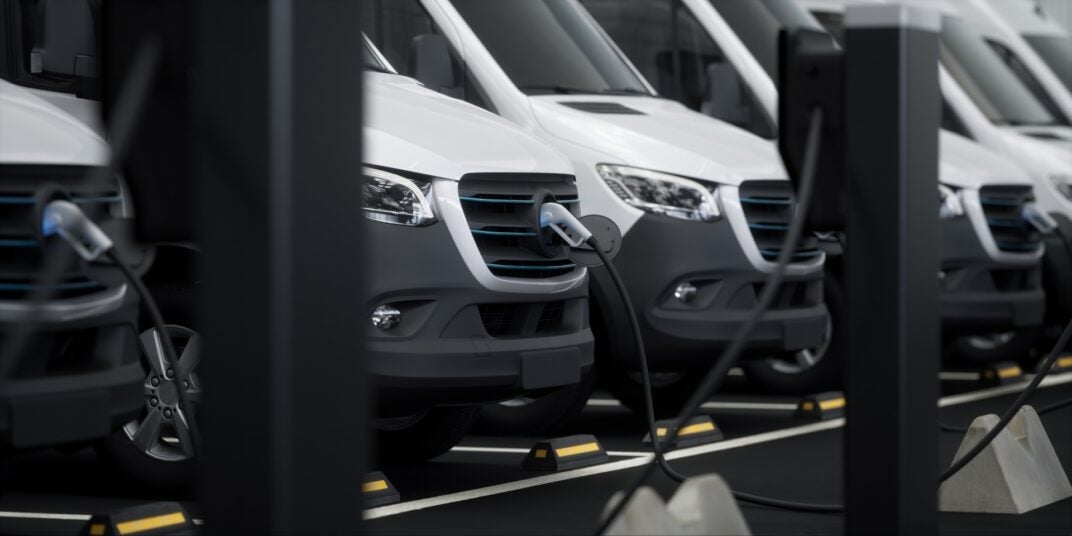Diesel costs are spiraling. A combination of sky-high demand, supply chain disruptions, and high taxes has driven the cost of crude oil through the roof — and logistics businesses are paying the price.
According to our July 2025 survey data, 52% of freight firms are now spending at least 20% of their monthly budgets on fuel, which is forcing senior leaders to look more closely at their options. One alternative is fleet electrification, which offers a genuinely compelling solution to the mounting financial pressures of keeping your fleet moving.
But is fleet electrification the best option for you and your business? In this guide, I’ll break down the process, the savings you can expect to make, and whether there are better alternatives for you to explore.
In this guide
What Is Fleet Electrification?
Fleet electrification refers to the process of replacing your traditional gasoline or diesel-powered vehicles with electric ones. Typically, a fleet manager will slowly retire vehicles with internal combustion engines (ICE) and roll out new electric vehicles (EVs) in their place.
The process has grown in popularity in recent years. Largely, this is due to legal compliance. While President Trump is waging war on EV mandates, certain states have enshrined adoption of EVs into law. California, for instance, mandates that all new trucks sold in the state must be EVs by 2035.
On the other side of the coin, high upfront costs are the single biggest deterrent for widespread electrification. But with crude oil prices rising by 11.3% in June alone, that may not be the case for long.
Is Electric Cheaper Than Diesel?
The short answer is yes, EVs are usually cheaper than their diesel alternatives over an extended period.
In terms of upfront costs, however, diesel vehicles are much cheaper because producing the large batteries that power EVs is expensive. Not only are they made up of multiple raw materials that are difficult to source, but the extraction process also commands a high price.
To complicate things further, most EVs feature advanced technology systems that will drive up their initial fee. Diesel vehicles, meanwhile, can be manufactured en masse at relatively cheap prices.
Setting all that to one side, though, EVs will save you significant amounts of money in the long run. In the next section, I’ll take you through the reasons why electric is cheaper than diesel in terms of total cost of ownership (TCO).
Why Is Electric Cheaper Than Diesel?
As mentioned above, EVs could potentially generate substantial savings for your fleet. Here, I’ll take you through some of the reasons why they’re cheaper than diesel vehicles.
Lower operating costs
Charging your truck is much cheaper per mile than putting gas in it, and across a whole fleet, those savings will really start to stack up. Electric vehicles are also set to become cheaper, with the cost of producing batteries projected to fall at a much faster rate than previously thought.
According to Forbes, heavy-duty vehicle (HDV) battery pack prices will fall to $85 per kilowatt-hour by 2030 — not the $123 that was originally estimated by the Environmental Protection Agency (EPA). The more common EVs become, the more that manufacturing and maintenance costs will fall.
Cheaper maintenance
EVs are much cheaper to maintain than diesel vehicles. Whereas the ICEs that power traditional vehicles are made up of hundreds of moving parts, EV motors comprise about 20 components. This means they’re much less likely to break down, as well as easier to fix when they do.
Whether you’re primarily conducting predictive or preventive maintenance, your diesel vehicles require substantial and costly upkeep throughout the year. This is borne out by our own research, which finds that “vehicle upkeep” and “managing financial pressure” are fleet managers’ two biggest priorities.
Cash incentives
A clean energy initiative enacted during the Biden administration, known as the Inflation Reduction Act (IRA), offers some tax credits for eligible EV owners. As per the legislation, qualifying EVs are entitled to $7,500, or $4,000 for used models, in tax credits.
However, this is soon coming to an end. With the passage of President Trump’s One Big Beautiful Bill, EV tax credits will expire for vehicles purchased or leased after September 30, 2025.
What Are the Biggest Barriers to Fleet Electrification?
While fleet electrification has a number of benefits, there are some notable drawbacks that merit consideration. In this section, I’ll take you through the biggest obstacles standing in the way of widespread fleet conversion.
High upfront costs
As we covered earlier, charging electric trucks is much cheaper per mile than putting gas in them. But unfortunately, at present, the infrastructure to support EV trucking fleets in the US isn’t developed enough to make the change cheaper.
According to research from fleet management platform Ryder, switching to a mixed fleet of electric light, medium, and heavy-duty vehicles will cost you up to 67% more than sticking with an equivalent fleet powered by fossil fuels.
Logistical difficulties
Electrifying your fleet isn’t as simple as replacing your old vehicles. In fact, you’ll likely encounter several difficulties with your new fleet, once again due to the comparatively sparse infrastructure on offer across the US.
For example, you will need to plan routes that pass by charging stations, which can be hard to come across in some areas.
Concerns over performance
EVs are not universally popular. Some detractors cite “range anxiety,” which refers to whether or not EVs can handle longer routes, demanding schedules, and inconsistent duty cycles. The combination of these factors can be enough to put fleet managers off.
Which Companies Have Successfully Transitioned to Electric?
In recent years, a number of companies have successfully converted their gas-guzzling fleets into electric vehicles. In this section, I’ll take you through some of the biggest examples.
Domino’s
The Michigan-based pizza juggernaut has 1,184 EVs on the road as of the end of last year. While there are no up-to-date figures, the company announced that it was “growing its fleet” in January 2025. Alongside this, it also plans to equip all of its vehicles with electric refrigeration units by 2028.
PepsiCo
As reported by The Wall Street Journal, PepsiCo is pushing ahead with its plans to reduce emissions by converting vehicles to electric, in spite of pushback from the Trump administration. At the time of writing, the company has over 1,750 such vehicles in its fleet, and plans to increase that number over the coming months.
Ryder System
The logistics company plans to add 4,000 EVs to its lease and rental fleets by the end of the year, which will allow freight firms to convert all their vehicles en masse, should they wish to. At present, the company offers light-duty electric commercial vans, medium-duty electric commercial trucks, and heavy-duty electric commercial tractors.
What Are the Alternatives to Electric Fleets?
Of course, gas and electric are not the only fuel types at a fleet’s disposal. One alternative is hydrogen, which boasts a superior range to electric, quick refueling time, and significantly lower emissions than conventional diesel vehicles.
Last year, it was revealed that General Motors would release a fleet of hydrogen-powered trucks as part of a pilot program sponsored by the Department of Energy. As it has a low energy content by volume, hydrogen is difficult to store. However, it can be really useful in the development of heavy-duty vehicles and mobile power generators, and it is gaining in popularity as a result.
Other options include biofuels, such as biodiesel. This is made from vegetable oils, animal fats, and reduced cooking oil, and emits up to 70% less carbon than traditional fuels. While progress in this area has been fairly minimal, Volvo expanded its range of biodiesel trucks last year.
At the time Jan Hjelmgren, Head of Product Management and Quality, Volvo Trucks, said the following: “As a global truck maker, we need to cater for a wide variety of transport needs and market conditions, which is why we do not only invest in new technologies, but also in solutions that decarbonize transport in the short and long term.”
Should You Convert Your Fleet to Electric?
The logistics industry is enduring a turbulent period. Fuel costs are going up, demand is increasing, and managers are still struggling to hire. Freight firms are under pressure to navigate these choppy waters while keeping costs low.
In this climate, fleet electrification offers a compelling solution to some of the issues that senior leaders are currently facing. By converting your existing fleet, you can make tangible savings on your vehicles in the long run. For businesses that are prepared to invest heavily upfront, the rewards can be massive.
Here at Tech.co, we understand that your business is unique. That’s why we spoke to 521 logistics professionals to inform our latest report, Moving Goods With Fewer Hands. It’s packed full of great insight on tariffs, automation, and more, so you can get an idea of how the industry is responding to the latest challenges and opportunities.

